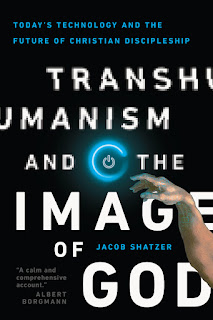"Transhumanism and the Image of God" by Jacob Shatzer. A Book Review
Transhumanism and the Image of God: Today's
Technology and the Future of Christian Discipleship
Jacob Shatzer
IVP Academic
InterVarsity
Press
PO Box 1400
Downers Grove, IL 60515
PO Box 1400
Downers Grove, IL 60515
ivpress.com
ISBN: 978-0-8308-5250-5;
April 2019; $22.00
5 Stars of 5
With the
growing matrix of social media, artificial intelligence, robotics, and prosthetic
enhancements, people should be asking all types of questions. And they are,
just not always the right ones. Some are asking “What more can be done?” while
others are inquiring “What should be done?” Jacob Shatzer, assistant professor
and associate dean in the School of Theology and Missions at Union
University, ordained Southern Baptist minister and author, addresses more of
the “What is going on, why, and how are we to rightly engage?” queries in his
new 192 page softback: “Transhumanism and the Image of God: Today's
Technology and the Future of Christian Discipleship.” Shatzer focuses on technological advances, the thinking going on
among transhumanists and posthumanists, and searches out ways for Christians to
decrypt the ought from the is. He writes for a broad spectrum of interested
people, and those who should be interested.
The main concept running through “Transhumanism and
the Image of God” is that we humans make tools, and then tools make us. We
construct technological tackling and it in turn molds our perceptions and
directions. Which means that technologies are “shaping us. And shaping people,
after all, is just another way of talking about discipleship” (8). Therefore,
“part of responsible, wise, faithful use of tools is analyzing the ways that
certain tools shape us to see the world in certain ways, and then to ask whether
those ways are consistent with the life of a disciple of Christ” (7). Thus, the
author argues “that Christians must engage today’s technology creatively and
critically in order to counter the ways technologies tend toward a transhuman
future…Human making is happening, and technology is a powerful part of that
making, sneaking its values into us at almost every turn” (11).
The first half of the book pointedly examines the
issue. In these first five chapters the author explains what transhumanism is and
how it undergirds a posthumanist aim. He unpacks the various pedigrees and personalities
that formed transhumanism and where they are (from Google to Facebook and
beyond). He looks into several of their tenets, where they are beneficial and
how they are problematic. Shatzer also attends to the transhumanist notion of
morphological freedom, which “means the ability to take advantage of whatever
technology a person wants to in order to change their body in any way they
desire” (56). This momentum continues, progressing to the place where the human
and machine merge bringing humans to augmented reality as well as to potential
mind clones.
The author perceives that many of these aspects are
already in their early stages, and we are unthoughtfully employing them from
our smartphones to our newest cutting-edge gadgets. Therefore, Shatzer
helpfully works through each item, and after explaining them and their advantageous
uses, thoughtfully works around how we should think about these advances and
changes, and where we should go; “If we want technology to serve the community,
then, it must be useful to move people toward the ultimate good not defined by
technology itself” (35). He further moves, in the last five chapter, to guiding
the reader to a more critical position by asking important questions, such as
what is real, where is real, who is real, and am I real? I appreciated how the
author exposes the clearly gnostic underpinnings that flow through our
technological advances – the desire to transcend the body because it is
expendable – and he grounds our rightful concerns and corrections in the
incarnation: “The doctrine of the incarnation shows us why full, embodied
humanity is the goal, and the importance of this doctrine warns us of danger in
embracing a version of humanity that rejects “in the body.” Jesus’ physical
presence is foundational” (122). The book, and especially the concluding
chapter, offers multiple suggestions on ways to manage technological uses in a
reader’s life.
“Transhumanism and the Image of God” is neither
shrill nor panic-stricken. The author helps the readers to keep their heads
about them while seriously engaging technology, transhumanists and
posthumanism. Clear and comprehensible, Shatzer makes a solid case, and gives sound
counsel. This volume is ideal for Christians involved with IT (which is almost
everyone I know!). If you have a smartphone, iphone, android, ipad, laptop, tablet,
etc. you should pick up a copy and make it a reading priority. I highly
recommend this book.
My thanks to IVP Academic for sending, at my
request, a copy of the book used for this review. They asked nothing in
exchange other than my honest opinion. And so all of the thoughts and remarks
are mine, freely given and freely bestowed.




Comments